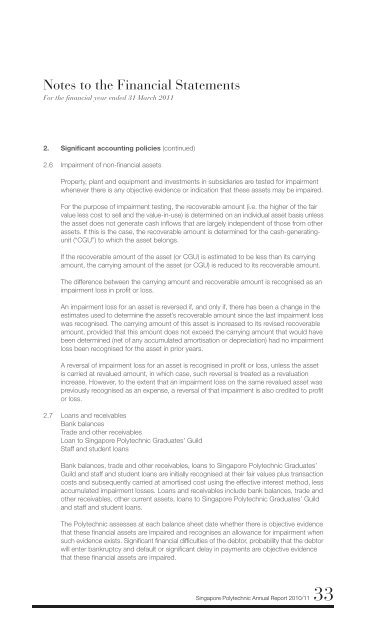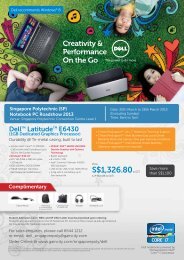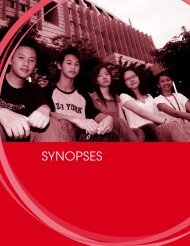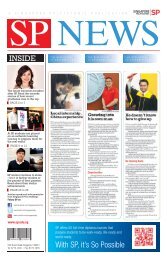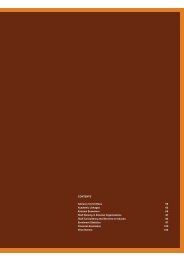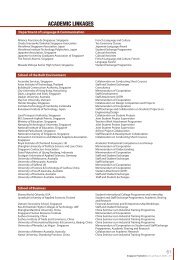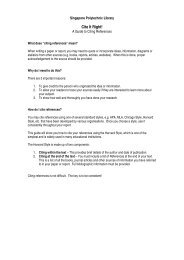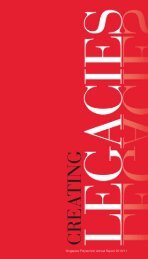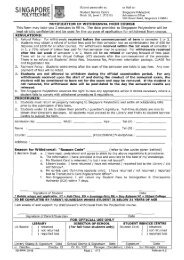CREA TING - Singapore Polytechnic
CREA TING - Singapore Polytechnic
CREA TING - Singapore Polytechnic
You also want an ePaper? Increase the reach of your titles
YUMPU automatically turns print PDFs into web optimized ePapers that Google loves.
Notes to the Financial Statements<br />
For the financial year ended 31 March 2011<br />
2. Significant accounting policies (continued)<br />
2.6 Impairment of non-financial assets<br />
Property, plant and equipment and investments in subsidiaries are tested for impairment<br />
whenever there is any objective evidence or indication that these assets may be impaired.<br />
For the purpose of impairment testing, the recoverable amount (i.e. the higher of the fair<br />
value less cost to sell and the value-in-use) is determined on an individual asset basis unless<br />
the asset does not generate cash inflows that are largely independent of those from other<br />
assets. If this is the case, the recoverable amount is determined for the cash-generatingunit<br />
(“CGU”) to which the asset belongs.<br />
If the recoverable amount of the asset (or CGU) is estimated to be less than its carrying<br />
amount, the carrying amount of the asset (or CGU) is reduced to its recoverable amount.<br />
The difference between the carrying amount and recoverable amount is recognised as an<br />
impairment loss in profit or loss.<br />
An impairment loss for an asset is reversed if, and only if, there has been a change in the<br />
estimates used to determine the asset’s recoverable amount since the last impairment loss<br />
was recognised. The carrying amount of this asset is increased to its revised recoverable<br />
amount, provided that this amount does not exceed the carrying amount that would have<br />
been determined (net of any accumulated amortisation or depreciation) had no impairment<br />
loss been recognised for the asset in prior years.<br />
A reversal of impairment loss for an asset is recognised in profit or loss, unless the asset<br />
is carried at revalued amount, in which case, such reversal is treated as a revaluation<br />
increase. However, to the extent that an impairment loss on the same revalued asset was<br />
previously recognised as an expense, a reversal of that impairment is also credited to profit<br />
or loss.<br />
2.7 Loans and receivables<br />
Bank balances<br />
Trade and other receivables<br />
Loan to <strong>Singapore</strong> <strong>Polytechnic</strong> Graduates’ Guild<br />
Staff and student loans<br />
Bank balances, trade and other receivables, loans to <strong>Singapore</strong> <strong>Polytechnic</strong> Graduates’<br />
Guild and staff and student loans are initially recognised at their fair values plus transaction<br />
costs and subsequently carried at amortised cost using the effective interest method, less<br />
accumulated impairment losses. Loans and receivables include bank balances, trade and<br />
other receivables, other current assets, loans to <strong>Singapore</strong> <strong>Polytechnic</strong> Graduates’ Guild<br />
and staff and student loans.<br />
The <strong>Polytechnic</strong> assesses at each balance sheet date whether there is objective evidence<br />
that these financial assets are impaired and recognises an allowance for impairment when<br />
such evidence exists. Significant financial difficulties of the debtor, probability that the debtor<br />
will enter bankruptcy and default or significant delay in payments are objective evidence<br />
that these financial assets are impaired.<br />
<strong>Singapore</strong> <strong>Polytechnic</strong> Annual Report 2010/11<br />
33


